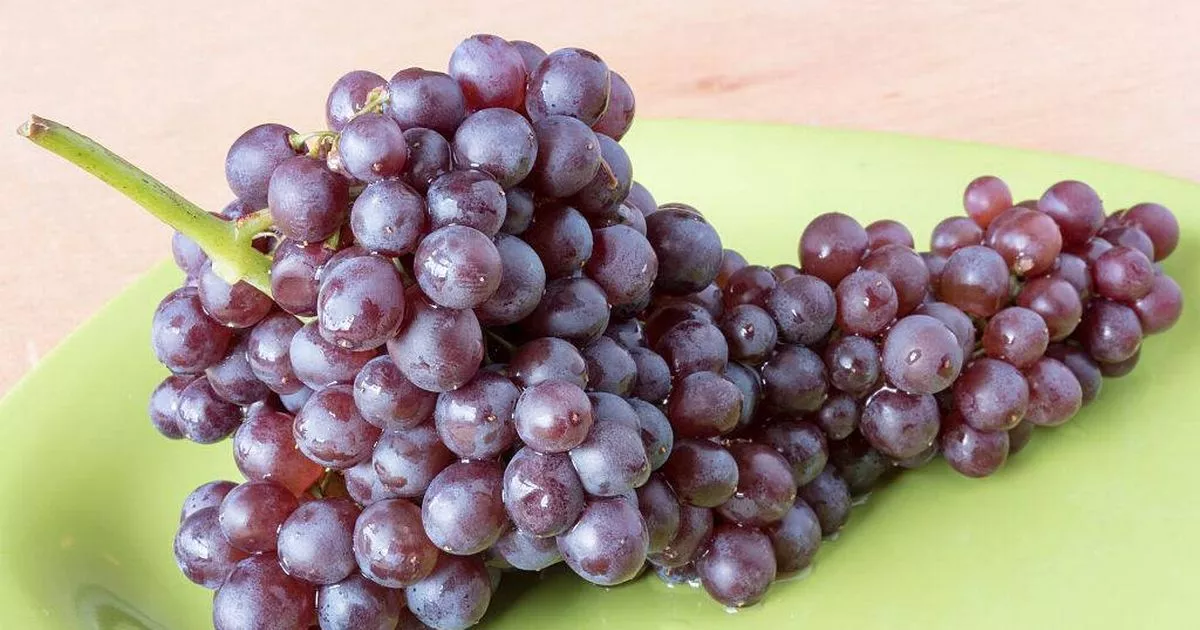By Charlotte Smith,Katie Green
Copyright cambridge-news

A unique new fruit has hit the shelves of UK supermarkets. The distinctive red berry grapes, which are called Boombites, are being hailed as a new “superfruit”.
They may look and taste like ordinary grapes, but once bitten into, they reveal a deep, juicy red pulp similar to that of a berry or cherry.
This novel fruit has been launched exclusively at M&S and Ocado, retailing at £3 per punnet. It boasts antioxidant levels on par with blueberries and triple the resveratrol content.
The fruit is rich in anthocyanins, which are the same polyphenols that give superfood status to berries such as goji and cranberry. These are associated with potential health-boosting mechanisms, including reduced inflammation, protection against cell damage, and promoting good gut health.
Preliminary research suggests that these red berry grapes could help regulate blood sugar levels, offering slower glucose uptake despite their natural sweetness. This could be a game-changer for fruit enthusiasts looking to maintain their health without sacrificing flavour, reports the Mirror.
Red berry grapes are poised to become an incredibly versatile new superfruit. Much like table grapes, they make for a ‘tasty’, healthy snack.
Their high antioxidant content also makes them ‘great for pre or post-workout’ or ‘just the perfect way to start your morning’.
The crimson berry grapes represent a natural hybrid between ‘some of the world’s finest’ table grapes, which conventionally feature white flesh inside, and heritage grape varieties boasting red flesh fruit that were historically reserved for wine making.
It required thousands of different pairings of small and tender, red-fleshed wine grapes with large, sweet, and crispy seedless table grapes to develop the innovative red berry grapes.
Anthocyanins are polyphenols, naturally occurring plant compounds. They are linked with health-boosting mechanisms including enhancements in cholesterol levels, vascular function and the gut microbiome.
Public Health Nutritionist Dr Emma Derbyshire, PhD, a member of a new research and education information group called the Red Berry Grape Advisory Board said: “Dark fruits have soared in popularity over recent years as people become familiar with their high antioxidant content. The vibrant colour of the red berry grapes is down to high concentrations of anthocyanins, a powerful antioxidant that’s been linked to a wide range of health and wellness benefits.”
Boombites also contain resveratrol, another naturally occurring polyphenol discovered in various plants, most notably in the skin of grapes, blueberries, raspberries, and peanuts.
Resveratrol is a stilbenoid, a type of natural phenol, manufactured by plants as a defence mechanism against pathogens or injury. Resveratrol is renowned for its antioxidant and anti-inflammatory qualities and has been linked to the “French paradox”.
This refers to the finding that France experiences lower heart disease rates than many similar nations, despite consuming a diet high in saturated fats.
Resveratrol is believed to provide numerous health and wellness advantages. Scientists at the University of Murcia examined Boombites and discovered they contained three times more resveratrol than blueberries and equivalent antioxidant levels.
Fresh research confirms that these novel red berry grapes not only provide significantly higher concentrations of antioxidant polyphenols compared to conventional grape varieties, but their natural sugars are also absorbed at a slower rate. It’s this effect on blood sugar levels that has sparked additional enthusiasm regarding their superfruit status.
Studies from Valencia’s AINIA technology centre in Spain indicate that whilst containing similar fructose quantities, the new red berry grape varieties demonstrated considerably reduced glucose uptake compared to standard types. This occurs because the red berry grape contains abundant polyphenols and fibre, and collectively, this distinctive food composition appears to play a part in reducing glucose absorption relative to other fruits.
Dietitian Nichola Ludlam-Raine, who sits on the red berry grape Advisory Board, explained: “In simple terms, this means that while new red berry grapes are sweet to the taste, the combination of phenols they contain alters the way these sugars are transported and absorbed in the gut.
“This has major implications for weight control, insulin response and dietary advice around fruit consumption, because we know that many consumers restrict intakes of these fruits rich in antioxidants because of concerns about the amount of sugar in fruit.”
Studies across populations demonstrate that consuming a diet abundant in polyphenols could potentially lower the likelihood of developing cardiovascular disease by 46%. This occurs through various pathways, including decreased oxidative stress and inflammation, plus enhancements in blood cholesterol levels, clotting mechanisms, and endothelial function – the term describing blood vessel integrity and flexibility.
An observational investigation involving 3,420 elderly participants at elevated cardiovascular disease risk – placing them also at heightened diabetes risk – revealed a 28% decrease in newly diagnosed diabetes amongst those consuming the greatest quantities of polyphenols. Additional research has demonstrated that polyphenols help regulate insulin resistance through various pathways whilst also working in combination with diabetes medications to boost their effectiveness.
Dr Emma Derbyshire summarised her thoughts by saying: “The red berry grape breaks the rules. Not only is it packed with potential health benefits, but it’s unique in its appearance and offers a juicy, hydrating, rewarding taste. You’ll have to bite it to believe it!”



